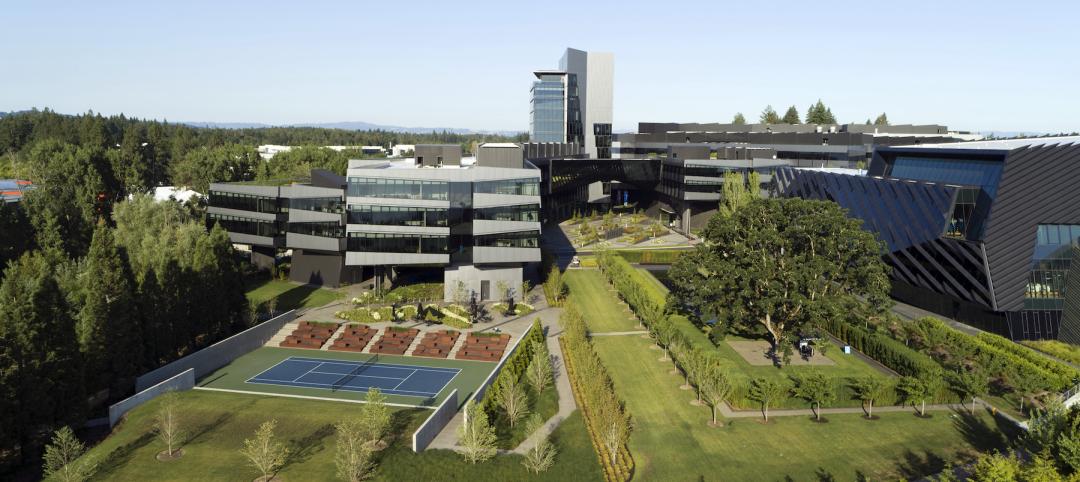The new Central Utility Plant (CUP) at Los Angeles International Airport (LAX) reached a major construction milestone when construction workers placed the final structural steel beam atop the building’s frame on January 24, 2012. Currently on schedule for construction completion in summer 2014, the $438 million (development cost) design-build project is being built by Clark/McCarthy, A Joint Venture.
In just four weeks, construction workers from Schuff Steel used a Manitowoc 999 Lattice-boom crawler crane with a reach of 140 feet to erect 1,400 tons of structural steel, creating the frame for the new CUP. An audience of approximately 300 project stakeholders and construction workers celebrated the ‘topping out’ during a ceremony held near the construction site. As a part of the event, attendees signed the final I-beam adorned with an American flag and an evergreen tree. The beam was then lifted 75 feet high and attached to the top of the structure. he tree represents growth, life and good luck for the construction workers and the building’s future occupants. The flag is displayed as a patriotic symbol that signifies the united effort by the project team to achieve a common goal.
The 70,000-square-foot facility has a steel frame that weighs in excess of 1,400 tons, or 40 pounds per square foot—about 30% higher than an OSHPD hospital in California.
The new CUP is being built to replace the existing 50-year old facility with a modern; state-of-the-art, computer managed utility plant providing enhanced passenger comfort and reliability of utility service and safety within the newly renovated modernized terminals at LAX. The existing CUP will service the airport throughout construction. Upon project completion, the replacement will be brought on-line and the old CUP will be decommissioned and demolished.
Serving as general contractor for the project, Clark/McCarthy’s contract includes demolition of the existing 50-year-old CUP as well as construction of a new 64,000-square-foot, steel-framed replacement CUP with a 20,000-ton cooling capacity. The project also entails the installation of associated equipment, such as a stand-by boiler, primary and secondary chilled water pumps, cooling towers, electrical systems and switchgear.
A new maintenance shop and offices and an above-grade thermal energy storage tank with capacity for 1.6 million gallons of water and 15,500 ton-hours of cooling is also being built. Other work includes: replacement of approximately 18 miles of pipe and duct bank that service the entire Central Terminal Area (CTA) with utility distribution, electrical and communications systems as well as reclaimed water, fire water and potable water systems; installation of several miles of new distribution piping throughout the CTA and beneath existing main entrance roadways throughout the airport; and an upgrade of pump rooms and air handling equipment in 21 different locations within all terminals, administrative buildings and the LAX Theme Building.
Systems and their components for the new CUP were designed and constructed to achieve LEED Silver certification from the U.S. Green Building Council.
Clark/McCarthy, A Joint Venture is a joint venture between Clark Construction Group and McCarthy Building Companies. Additional project partners include: Gruen Associates, Los Angeles, architect; Arup, Los Angeles, mechanical, electrical, plumbing, structural, and commissioning engineer; Capital Engineering Consultants, Rancho Cordova, Calif., mechanical consultant; Greenform, Los Angeles, sustainability consultant; and PID Engineering, San Diego, cogeneration consultant. BD+C
Related Stories
Codes and Standards | Aug 3, 2022
Some climate models underestimate risk of future floods
Commonly used climate models may be significantly underestimating the risk of floods this century, according to a new study by Yale researchers.
| Aug 3, 2022
Designing learning environments to support the future of equitable health care
While the shortage of rural health care practitioners was a concern before the COVID-19 pandemic, the public health crisis has highlighted the importance of health equity in the United States and the desperate need for practitioners help meet the needs of patients in vulnerable rural communities.
Reconstruction & Renovation | Aug 3, 2022
Chicago proposes three options for Soldier Field renovation including domed stadium
The City of Chicago recently announced design concepts for renovations to Soldier Field, the home of the NFL’s Chicago Bears.
Codes and Standards | Aug 2, 2022
New tools help LEED projects reach health goals
The U.S. Green Building Council now offers tools to support the LEED Integrative Process for Health Promotion (IPHP) pilot credit.
Market Data | Aug 2, 2022
Nonresidential construction spending falls 0.5% in June, says ABC
National nonresidential construction spending was down by 0.5% in June, according to an Associated Builders and Contractors analysis of data published today by the U.S. Census Bureau.
K-12 Schools | Aug 1, 2022
Achieving a net-zero K-12 facility is a team effort
Designing a net-zero energy building is always a challenge, but renovating an existing school and applying for grants to make the project happen is another challenge entirely.
Healthcare Facilities | Aug 1, 2022
New Phoenix VA outpatient clinic is one of the largest veteran care facilities in the U.S.
The new Phoenix 32nd Street VA Clinic, spanning roughly 275,000 sf over 15 acres, is one of the largest veteran care facilities in the U.S.
Codes and Standards | Jul 29, 2022
Few projects and properties are being built beyond code
Clients and architects disagree on how well building to code provides resilience, according to a recent report by the American Institute of Architects (AIA) in partnership with Owens Corning.
Headquarters | Jul 29, 2022
Nike HQ’s newest, largest structure: the Serena Williams Building
In Beaverton, Ore., the new Serena Williams Building, at just over 1 million square feet, is the largest structure at Nike World Headquarters.
| Jul 28, 2022
Fanning Howey hires Dennis Bane, AIA, as Project Executive
Fanning Howey, an architecture, interiors and engineering firm specializing in learning environments, has hired Dennis Bane, AIA, ALEP, to serve as a Project Executive for the firm’s Indianapolis office.

















